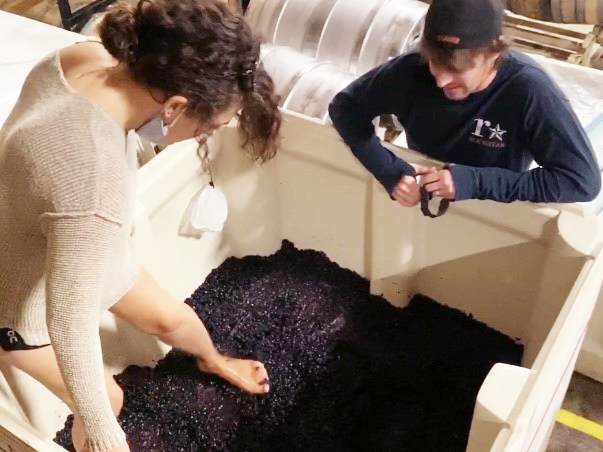
My wife Breauna foot treading the 2020 Estate Reserve Pinot Noir. The fruit smelled and tasted incredible, but we didn’t know at this point whether we would be able to keep the wine, since smoke flavors can be unlocked later in a finished wine in the mouth.
We are really happy to be sharing the new wines with you. 2020 was one of the most challenging vintages we’ve ever faced — despite a fantastic growing season — because of regional wildfires and the potential for smoke impact. I’m thankful to say that we crafted wonderful wines, and we know you will love them. I’m sure some of you are curious about our analysis, conclusions, and why I’m confident about the wines. Here are the bullet points, and if you want to do more of a geeky deep dive I can go into it a little more, later this spring.
- During the 2020 fires, I talked daily with fellow winemakers to share data and observations (and anxiety and sadness). We attended seminars hosted by UC Davis, enology laboratories, and insurance companies. We obsessively dug through the limited literature and studies on smoke taint.
- Initially, many wineries hurriedly made decisions on whether or not to pick vineyards based on lab results. In hindsight, these measurements and the related discussions were generally meaningless. In the first weeks I didn’t know that yet, but I decided to go ahead and pick about half the estate, figuring I might as well make some wine while I learned everything I could. I would throw it out later if need be.
- It turns out that smoke taint is a potential wine flaw that cannot (currently, at least) be predicted by, or later confirmed by, laboratory analysis. This is primarily because — unlike a direct measurement such as volatile acidity, a biological measurement like brettanomyces, or even a chemical compound measurement like cork taint — the compounds that cause smoke taint are naturally found in wine. A lab can’t tell you if wine suffers from smoke taint any more than it can tell you if it’s overly earthy, or overly spicy, or overly vegetal, or overly fruity.
- For example, a local lab advised that a finished wine with free guaiacol of 6ppb or higher would be “very likely” to suffer from smoke taint. Well, to compare apples to apples we sent in 2019 barrel samples (neutral oak) for analysis… and they showed a free guiacol of 6ppb… even though that vineyard had seen zero smoke that year. Yes, you read that right.
- I could go into some very fine-grained detail here with my spreadsheets and charts, but to sum up, smoke taint is understudied and poorly understood, and cannot yet be reliably measured in a lab. In the process of coming to this conclusion with many of my peers, I did do lab analysis on our 2020 fruit, including having field samples tested locally and also later sending finished wine samples to a lab in Australia. The results were essentially inconclusive, for the reasons explained above. It became clear that smoke taint is — at this point in science — a wine sensory characteristic, so we treated it as such. The most logical and reliable approach was to consider factors such as distance between vineyard and fire — and more than anything, to trust my palate and the palates of the other winemakers who tasted my wines.
- The 2020 wines we’re releasing do not show smoke influence.
- Enjoy.